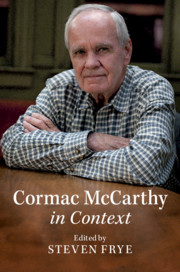Book contents
- Cormac McCarthy in Context
- Cormac McCarthy in Context
- Copyright page
- Contents
- Contributors
- Acknowledgments
- Chronology
- Part I Environments
- Part II Literary Contexts: Sources, Influences, Allusions
- Part III Intellectual Contexts
- Chapter 12 The Judeo-Christian Tradition
- Chapter 13 Gnosticism
- Chapter 14 Classical and Pre-Classical Philosophy
- Chapter 15 Nineteenth- and Twentieth-Century Philosophy
- Chapter 16 Formal Aesthetic Choices
- Chapter 17 Science and Technology
- Part IV Social and Cultural Contexts
- Part V Archives, Critical History, Translation
- Works Cited
- Index
Chapter 16 - Formal Aesthetic Choices
from Part III - Intellectual Contexts
Published online by Cambridge University Press: 12 December 2019
- Cormac McCarthy in Context
- Cormac McCarthy in Context
- Copyright page
- Contents
- Contributors
- Acknowledgments
- Chronology
- Part I Environments
- Part II Literary Contexts: Sources, Influences, Allusions
- Part III Intellectual Contexts
- Chapter 12 The Judeo-Christian Tradition
- Chapter 13 Gnosticism
- Chapter 14 Classical and Pre-Classical Philosophy
- Chapter 15 Nineteenth- and Twentieth-Century Philosophy
- Chapter 16 Formal Aesthetic Choices
- Chapter 17 Science and Technology
- Part IV Social and Cultural Contexts
- Part V Archives, Critical History, Translation
- Works Cited
- Index
Summary
Cormac McCarthy’s aesthetic choices make him as anachronistic and difficult to place as are many of his characters. While he shares some of the thematic preoccupations of modernism and postmodernism, he lacks most of the aesthetic markers of those movements. Given his varied style, it might be more promising to think of his work as hovering aesthetically between the naturalistic and the phantasmagoric in the manner of Hawthorne’s and Melville’s romance tradition. His aesthetic borrowings from the medium of film similarly seem to place his work in a grey area between objectivity and subjectivity. While McCarthy’s own consistent associations of aesthetic value with pain and loss contrast sharply with the disinterested conception of beauty propounded by Kant, his work seems much more attuned to Kant’s other source of aesthetic value, the sublime. But McCarthy’s version of the sublime is thoroughly naturalized and historicized, embracing human fragility and contingency. This aspect of McCarthy’s aesthetic, linked as it is to the cultural attitudes born of the nineteenth-century encounter between late Romanticism and naturalism, might help account for many readers’ sense that McCarthy’s work belongs to another time.
Keywords
- Type
- Chapter
- Information
- Cormac McCarthy in Context , pp. 169 - 179Publisher: Cambridge University PressPrint publication year: 2020

